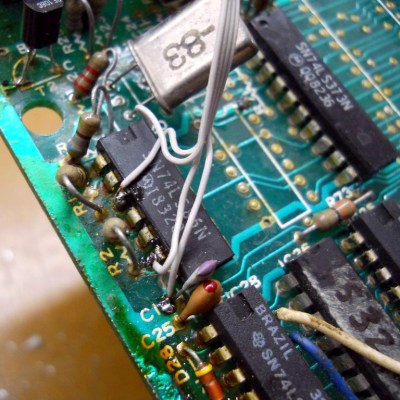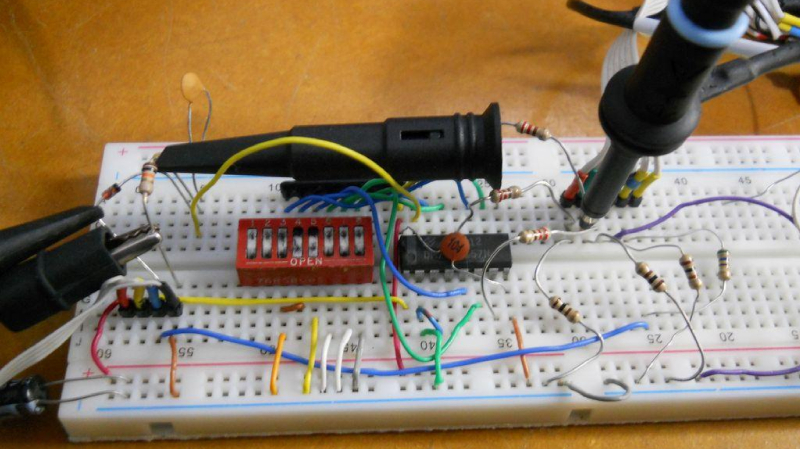[danjovic] is a vintage computer enthusiast and has several old computers in his collection. Among them are a couple of TK-85 units – a ZX81 clone manufactured by Microdigital Eletronica in Brazil. The TK-85 outputs a monochrome video output. And when [danjovic] acquired a SyncMaster 510 computer monitor, he went about building a circuit to “colorise” the output from the ZX81 clone (Portuguese translation).
The SyncMaster 510 supports 15kHz RGB video refresh rate, so he thought it ought to be easy to hook it up to the TK-85, which internally has the video and composite sync signals available. So, if he could lower the amplitude of the video signal to 0.7Vpp, using resistors, and connect this signal to one of the primary colors on the monitor, for example green, then the screen should have black characters with a green background.
 Before he could do any of this, he first had to debug and fix the TK-85 which seemed to be having several age related issues. After swapping out several deteriorating IC sockets, he was able to get it running. He soldered wires directly to one of the logic chips that had the video and sync signals present on them, along with the +5V and GND connections and hooked them up to a breadboard. He then tested his circuit consisting of the TTL multiplexer, DIP switches and resistors. This worked, but not as expected, and after some digging around, he deduced that it was due to the lack of the back porch in the video signal. From Wikipedia, “The back porch is the portion of each scan line between the end (rising edge) of the horizontal sync pulse and the start of active video. It is used to restore the black level (300 mV.) reference in analog video. In signal processing terms, it compensates for the fall time and settling time following the sync pulse.”
Before he could do any of this, he first had to debug and fix the TK-85 which seemed to be having several age related issues. After swapping out several deteriorating IC sockets, he was able to get it running. He soldered wires directly to one of the logic chips that had the video and sync signals present on them, along with the +5V and GND connections and hooked them up to a breadboard. He then tested his circuit consisting of the TTL multiplexer, DIP switches and resistors. This worked, but not as expected, and after some digging around, he deduced that it was due to the lack of the back porch in the video signal. From Wikipedia, “The back porch is the portion of each scan line between the end (rising edge) of the horizontal sync pulse and the start of active video. It is used to restore the black level (300 mV.) reference in analog video. In signal processing terms, it compensates for the fall time and settling time following the sync pulse.”
To implement the back porch, he referred to an older hack he had come across that involved solving a similar problem in the ZX81. Eventually, it was easily implemented by an RC filter and a diode. With this done, he was now able to select any RGB value for foreground and background colors. Finally, he built a little PCB to house the multiplexer, DIP switches and level shifting resistors. For those interested, he’s also documented his restoration of the TK-85 over a four-part blog post.
















Great!
Any way to make that green on black?
I was going to write that you could use the inverting input of an op-amp, but then read through the write-up. He already implemented a way to choose colors for text and background.
I had a wierd thought about this subject last night, before I read this article. You know the old 1-chip Pong consoles so many companies made? There was also a chip you could buy that added colour to the monochrome Pong chip. The Pong chip itself had separate video outputs for left bat, right bat, ball, playfield etc. These were normally just tied together. But if fed into the colourising chip, it’d output them in a colour each. So wouldn’t the colourising chip work on any mono video? You could at least have mono with a choice of 4 or so colours. Or if you connected this chip to a Z80 I/O port, you might be able to do split-screen tricks to colourise different parts of the screen.
The challenge of course is getting the chip!
That’s the AY-3-8515 colouriser, btw. Took a sync input, and output a colour burst. Would also output colours when it’s playfield / left bat / etc inputs were stimulated. You could even, maybe, stick a RAM chip onto it, correctly addressed, with each bit of RAM connecting to a different input, therefore colour. I’d love to see this chip abused. For 1976 or so it would have been a lot of fun to use it to generate a colour bitmap display, with a 1K SRAM or so, or maybe even one of the big shift register memories. Anyone know of a supplier 39 years later?
Man, the chip’s older than I am. Not by much though.
I wonder what happens if you drive more than one of its Video In signals high simultaneously? Clearly not the original intended case.
15 kHz looks like an odd number for a refresh rate. At least 100 times too high for vertical refresh rate and about three times too low to be horizontal synchronisation frequency. Huh?
15 kHz was the standard for arcade monitors.
15,734 kHz is the standard horizontal frequency for NTSC video (USA standard for analog video). PAL (European analog video) is a similar frequency. Vertical rates are 60/30 Hz for NTSC and 50/25 Hz for PAL.
I believe that Brazil used a weird hybrid system called PAL-M, which was PAL colour and NTSC line number, frequency range, etc, so that might explain it.